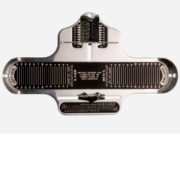How To Find Your Correct Shoe Size
Having your feet measured professionally is a good idea when shopping for shoes. As we age, our feet grow when the tendons and ligaments lose elasticity. The results are that the toes spread out, the arch flattens, and the feet become longer and wider.
Using The Brannock Device
This strange-looking metal device used to measure your feet in shoe stores is called a Brannock Device. It has been in use for almost 100 years!
Charles F. Brannock came from a shoe industry family and wanted an improved means of measuring the length and width of your feet and the height of the arch. The foot-measuring device that we know today as the Brannock device gives accurate measurements of both right and left feet and is the international footwear industry standard.
There are models for men’s shoe sizing, women’s and children’s, and specialized types for athletic shoes and ski boots. Even the Smithsonian Institution recognizes its contribution to the American industry and houses samples of some of the first Brannock devices.
Getting the Right Shoe Fit Is Important
Studies show that only about 37% of people wear shoes of the correct length and width! Are you one of them? Wearing shoes that are too short, too narrow, or too tight can cause some significant foot problems, including:
- Neuropathy: Pins and needles in the feet and decreased sensation can be caused by tight-fitting shoes that put pressure on the nerves.
- Hammertoe: Shoes that are too narrow in the toe box can force toes to bend unnaturally into the hammertoe shape. Besides being painful, the skin of the hammertoe can have corns and calluses from footwear pressure against bony spots.
- Ingrown toenails: Pressure on the toe from poorly fitting shoes can force the edge of a toenail to grow into the skin and become infected.
- Bunion: Although tight shoes won’t cause a painful bunion, they can worsen it by pushing the big toe.
Foot pain from poorly-fitting shoes can also cause mobility issues and falls. Play it safe – measure both feet at least twice yearly for foot comfort and safety.
Board-certified podiatrist Dr. Naghmeh Lilly Khavari is committed to helping her clients in Carrollton, TX. She offers a wide variety of treatments, from ingrown toenails to advanced surgical solutions. Contact Carrollton Foot Center’s office at 469-998-3668 to schedule an appointment today!




